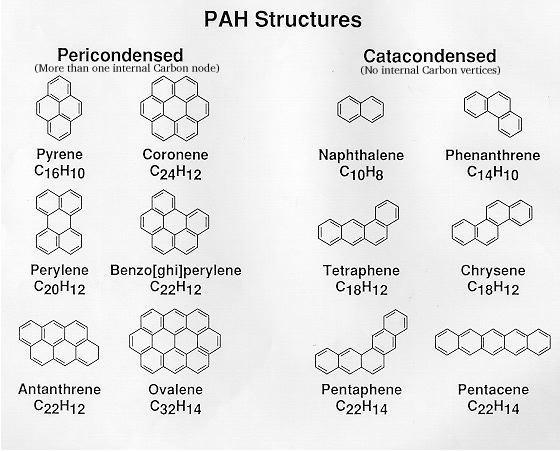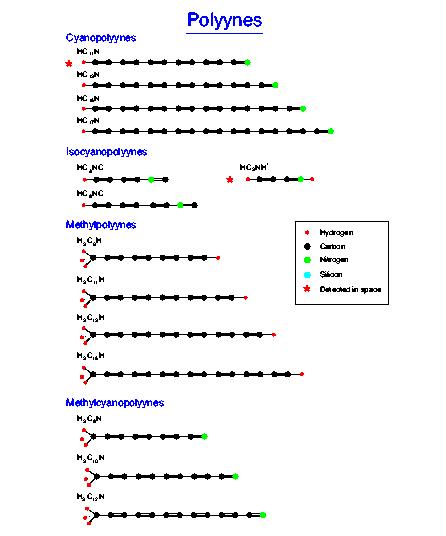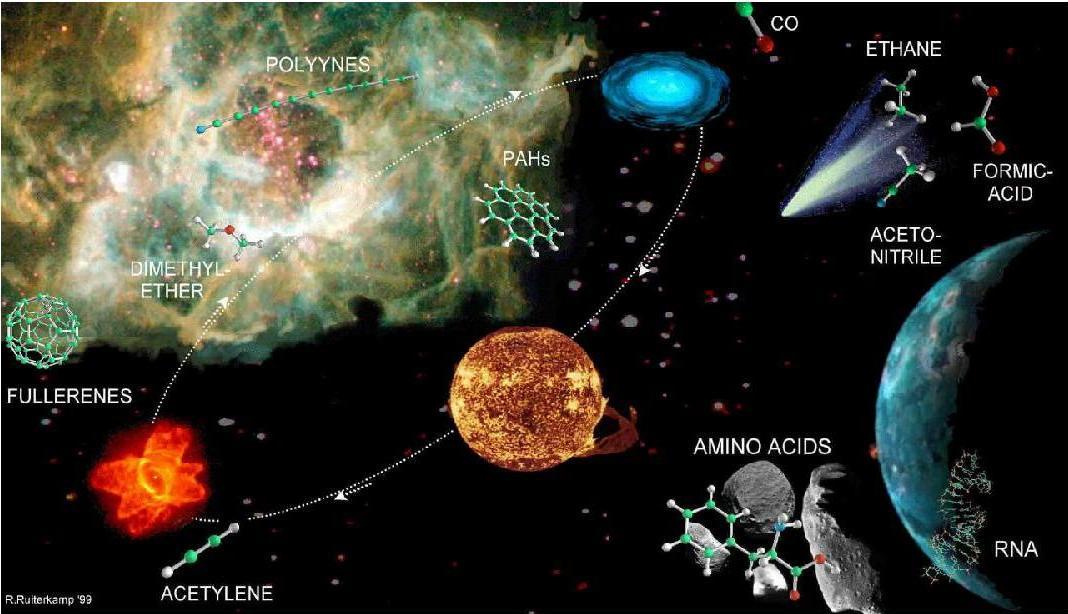Molecules have been observed in astronomical environments as diverse as comets in the solar system and galaxies at the highest redshifts. They act as excellent probes of the physical structure and dynamics of such regions, owing to the complexity of their energy level structure and the resulting emission and absorption spectra. In addition, molecules also play an active role in the energy balance of clouds. Interstellar space is a unique laboratory in which chemical processes can occur that are not normally found on Earth. Astrochemistry, a highly interdisciplinary subject, links the macrocosm (galaxies, stars, planets) with the microcosm (basic chemical processes and spectroscopy).
The ground-and space-based observational facilities over complete wavelength range makes it possible to study the development of molecular complexity throughout the universe.
The illustration, taken from "Organic Molecules in the Interstellar Medium, Comets and Meteorites: A Voyage from Dark Clouds to the Early Earth", Pascale Ehrenfreund & Steven B. Charnley, Annual Review of Astronomy & Astrophysics, 38:427-83, 2000, shows the evolutionary cycle of Interstellar organic matter:
Star formation in the dense dark clouds - Circumstellar disc leading to possible formation of the planetary system, comets & asteroids - Organic matter from dark clouds is incorporated into the solar system - Formation of more complex organics and evolution of life - Stars end their lives ejecting the outer layers to further enrich the Interstellar medium.
Carbon plays a very important role also in Space Astrochemistry. The interstellar clouds contain simple Carbonaceous molecules such as CO, formaldehyde, ether etc. but also more complex species like polyynes, Polycyclic aromatic hydrocarbons, Fullerenes etc., which along with graphite and chains makeup for a large fraction of Interstellar Carbon. CO and Cyanide can be detected in young stellar objects. Amino acids and formic acid are detected in meteorites and comets. Biomolecules on Earth.
[Back to picture / Home page]
Polycyclic Aromatic Hydrocarbon (PAH)
PAH molecules comprise of planar hexagonal rings of carbon e.g.
Benzene, Naphthalene, pyrene, Coronene, Ovalene etc. They belong to one of the
most stable families of organic compounds. PAH molecules are now believed to be
ubiquitous in a variety of Astrophysical environments. Their presence is
inferred via the strong infrared emission features at 3.3, 6.2, 7.7, 8.6, 11.2
and 12.7 micro meter observed in Planetary nebulae, reflection nebulae, H II
regions and even in extragalactic sources. These features definitely belong to
the aromatic family yet no particular PAH has been confirmatively identified. PAHs can be present in neutral, ionized, hydrogenated or dehydrogenated forms depending on the Physical conditions of Astrophysical environment. In the illustration PAHs are at the edges of dense clouds. PAHs are also major components of soot in the terrestrial environment. They are
important pollutants and also Carcinogenic.
 [Back to picture / Home page]
[Back to picture / Home page]
Carbon Chains and Polyynes
Carbon chains are unsaturated organic linear molecules not seen on Earth because of their instability in our oxygen-containing atmosphere. They are cumulenes, polyacetylenes and cyanopolyynes (HCnN). These are detected in Interstellar medium via their rotational spectra, the largest being 13 atomic HC11N. The dense clouds contain polyynes and other organics like formaldehyde etc.
 [Back to picture / Home page]
[Back to picture / Home page]
Fullerenes C60
Fullerenes or Buckyballs are large spherical football shaped extremely stable molecules made up of hexagonal and pentagonal Carbon structures. The most common is C60 but there are C70, C76, C84 and many more and Nanotubes. They are found not only in the dark clouds but also in terrestrial carbon rich rocks. The fullerenes and nanotubes have many unique properties. C60 shows superconducting properties with Alkali atoms.
[Back to picture / Home page]
Molecules of Biological importance
Amino acids and Nucleic acids make up proteins and the RNA/DNA the building blocks of life as we know it on earth. RNA consists of one strand of nucleic acids linked together by phosphodiester bonds. The DNA molecule consists of two strands of nucleotides twisted together to form a double helix. The basic atomic units of such biomolecules formed in the stars. Molecules responsible for origin of life, it seems, already started forming in the interstellar medium.
[Back to picture / Home page]




